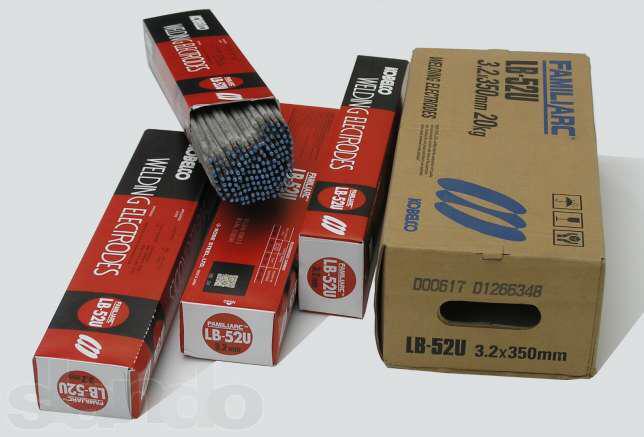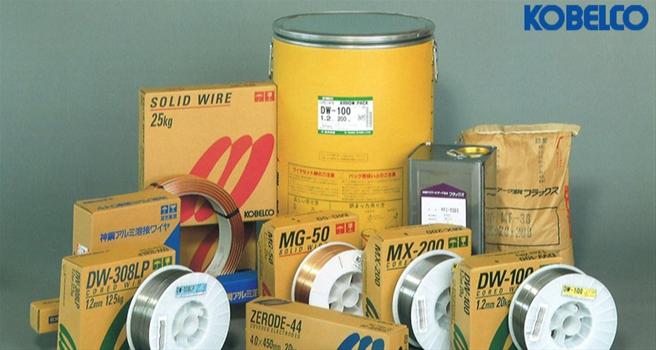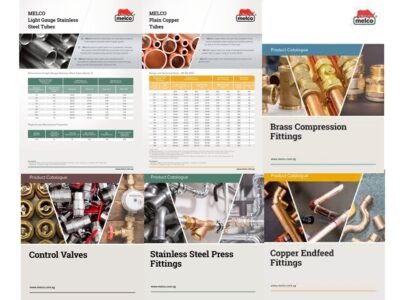Description
1. Welding electrodes for carbon steel
 |
a. RB-26 |
 |
b. B-10 |
 |
Applications
Shielded metal arc welding vehicles, building and other general structures made of mild steel. For all-position welding of general structures. |
 |
 |
Characteristics on usage
| – |
B-10 is an ilmenite type covered electrode, which is designed for better usability to be suitable for butt or fillet welding in all positions for thin or thicker plate (106 to 2.0mm) due to wide range of the electrode sizes. |
| – |
In particular, it is hard to cause slag inclusion and lustrous bead can be obtained due to stable slag covering in flat welding. |
| – |
The penetration is deeper compared with high titania and lime titania type electrodes. |
| – |
It is suitable for welding joint where better penetration is required even for a thin plate. |
|
 |
 |
Notes on usage
| – |
Pay attention not to exceed the range of proper currents. Welding with excessive current not only lower X-ray soundness, but also causes increase of spatter, undercut and insufficient slag covering. |
| – |
Dry the electrodes at 70-100° C for 30-60 minutes before use. Excessive moisture absorption lower usability and may result in some porosities. |
| – |
Excessive drying before use causes less penetration and overheating of the electrode. |
| – |
Medium or heavy thick plate should be welded under proper preheating and interpass temperatures. |
|
 |
c. B-14 |
 |
Applications
Shielded metal arc welding of heavy-duty structures as ships, vehicles, buildings and bridges made of mild steel. For all-position welding of heavy-duty structures. |
 |
 |
Characteristics on usage
| – |
B-14 is an ilmenite type covered electrode designed for better usability and weld ability. It is suitable for butt or fillet welding in all positions for thin or thicker plate (1.6 to 2.0mm). |
| – |
In horizontal fillet welding, slag covering and bead uniformity are good and bead appearance is beautiful. |
| – |
Its usability in vertical or overhead welding is best among ilmenite type electrodes. |
| – |
Due to good X-ray soundness and mechanical properties, B-14 is used for skill testing and competition by choice. |
|
 |
 |
Notes on usage
| – |
Pay attention not to exceed the range of proper currents. Welding with excessive current not only lower X-ray soundness, but also causes increase of spatter, undercut and insufficient slag covering. |
| – |
Dry the electrodes at 70-100° C for 30-60 minutes before use. Excessive moisture absorption lower usability and may result in some porosities. |
| – |
Excessive drying before use causes less penetration and overheating of the electrode. |
| – |
Medium or heavy thick plate should be welded under proper preheating and interpass temperature. |
|
 |
d. B-17 |
 |
e. LB-26 |
 |
Applications
Shielded metal arc welding of general heavy structural steels for ships, buildings, bridges and pressure vessels made of mild steel. For welding of heavy-duty structures and heavy plates. |
 |
 |
Characteristics on usage
| – |
LB-26 is a low hydrogen type covered electrode containing iron powder in its coating so that the welding efficiency can be improved. |
| – |
The weld metal provides good X-ray soundness and mechanical properties. |
| – |
The welding in all positions can be easily done with the good usability of stable arc, good slag removability and good bead appearance. |
|
 |
 |
Notes on usage
| – |
Dry the electrodes at 300-350°C for 30-60 minutes before use. |
| – |
Take the back step method or strike the arc on a small steel plate prepared to prevent blowholes at the arc starting. |
| – |
Keep the arc as short as possible. |
|
2. Welding electrodes for 490 N/mm2 high-tensile steel
 |
a. LB-52 |
 |
b. LB-52-18 |
 |
c. LB-52U |
3. High cellulose-type electrodes
 |
KOBE-6010 |
 |

Applications and Features
| – |
A high cellulose type electrode for API grades up to X52 steels on DC current only. |
| – |
Suitable for all-position welding of pipes and general structures including vertical downward position. |
| – |
Weld penetrations deeper, less slag makes welding manipulation easier, porosities are not easily formed, and X-ray soundness is better. |
|
4. Welding electrodes for stainless steel
 |
a. NC-38 |
 |
b. NC-38L |
 |
c. NC-39 |
 |
Applications
| – |
Shielded metal arc welding of 22%Cr-12%Ni steel such as SUS309S. |
| – |
Welding of dissimilar metals such as stainless steel and carbon steel or low alloy steel. |
|
 |
 |
Characteristics on usage
| – |
NC-39 and HIMELT-309 are lime-titania type electrodes, and HIMELT-309 makes higher welding efficiency by higher amperage. |
| – |
As the weld metals contain larger quantity of ferrite in austenitic structure, the weld ability is good and they provide good corrosion resistibility and good heat resistibility in as-welded condition. |
| – |
As the weld metals contain much quantity of alloying elements and have stable austenitic structure, they are suitable where the dilution by a base metal of carbon steel or low alloy steel is considerable. |
|
 |
d. NC-39L |
 |
Applications
| – |
Shielded metal arc welding of dissimilar metals such as stainless steel to carbon steel or low alloy steel. |
| – |
Under layer welding of the cladded side groove of SUS304L clad steel, or of 308L weld overlaying onto carbon steel or low alloy steel. |
|
 |
 |
Characteristics on usage
| – |
NC-39L and HIMELT-309L are lime-titania type electrodes, and HIMELT-309L makes higher efficiency by higher amperage. |
| – |
As the weld metals contain larger quantity of ferrite in austenitic structure, the weld ability is good. |
| – |
They provide good corrosion resistibility and good heat resistibility in as-welded condition. |
| – |
They are suitable where the dilution by base metal carbon steel or low alloy steel is considerable. |
|
 |
e. NC-36 |
 |
Applications
Shielded metal arc welding of 18%Cr-12%Ni-2%Mo stainless steel such as SUS316. |
 |
 |
Characteristics on usage
| – |
NC-36 and HIMELT-316 are lime-titania type electrodes, and HIMELT-316 makes higher welding efficiency by higher amperage. |
| – |
As the weld metals contain proper quantity of ferrite in austenitic structure, the crack resistibility is excellent. |
| – |
Especially the corrosion resistance against diluted sulfuric acid is excellent. |
| – |
The mechanical properties of the weld metals at elevated temperatures are superior to NC-38. |
| – |
Heat resistibility and corrosion resistibility of the weld metals are excellent in as-welded condition. |
|
 |
f. NC-36L |
 |
Applications
Shielded metal arc welding of low carbon 18%Cr-12%Ni-2%Mo stainless steel such as SUS316L. |
 |
 |
Characteristics on usage
| – |
NC-36L and HIMELT-316L are lime-titania type electrodes, and HIMELT-316L makes higher welding efficiency by higher amperage. |
| – |
As the weld metals contain proper quantity of ferrite in austenitic structure, the crack resistibility is excellent. |
| – |
The intergranular corrosion resistibility us superior to that of NC-36 and HIMELT-316L, due to lower carbon content. |
|
5. Welding electrodes for cast iron
 |
CIA-1, CIA-2, CIA-3 |
6. Welding electrodes for hard-surfacing
 |
a. HF-350 |
 |
b. HF-500 |
 |
Applications
Hard surfacing of idlers and trucks links of bulldozers. For metal-to-metal wearing and light abrasions. |
 |
 |
Characteristics on usage
| – |
HF-500 deposits the weld metal of martensite structure, which has good toughness. |
| – |
It is applicable to severe metal-to-metal wearing and abrasion accompanied by light impact. |
| – |
It is difficult to apply machining on the weld metal. |
|
 |
 |
Notes on usage
| – |
Preheat at 150°C and over in general. |
| – |
In the case of multi-layer hard surfacing or hard surfacing onto large size casting steels and forgings, low alloy steels, or high carbon steels, under layer welding with low hydrogen type electrodes for mild steel should be applied. |
|
 |
c. HF-600 |






























































































































